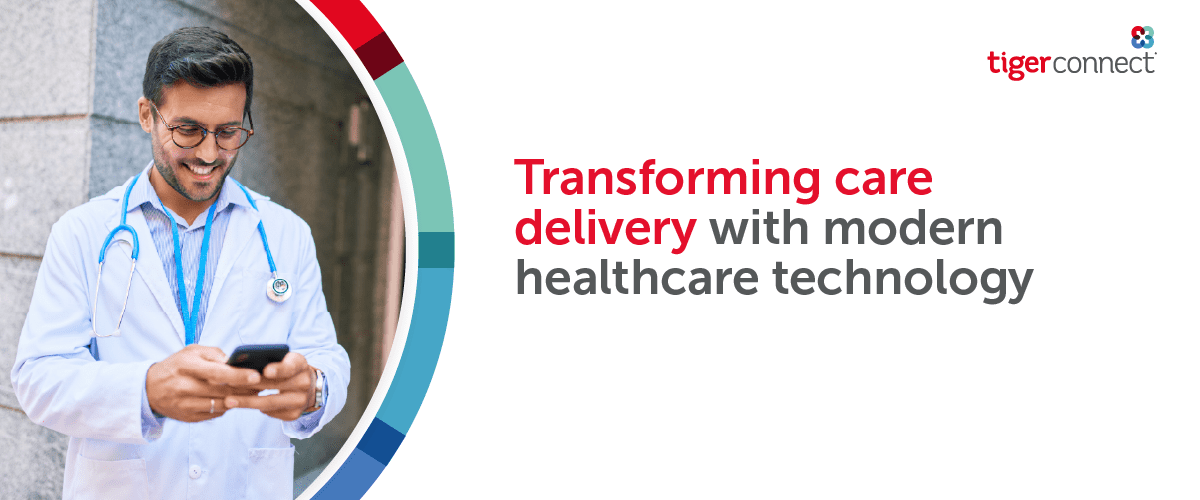Home / Blog /
Transforming care delivery with modern healthcare technology

Transforming care delivery with modern healthcare technology
Gartner® says healthcare provider CIOs will “accelerate care delivery transformation and optimization by delivering new digital capabilities.”
Speed is key in care delivery. New technology that improves the speed of information flow between team members can increase operational efficiency and positively impact patient outcomes. Today, every healthcare organization has software that handles some complex tasks, but there are additional technology investments to explore.
As Gartner® explains, healthcare provider CIOs will “accelerate care delivery transformation and optimization by delivering new digital capabilities.” While cybersecurity concerns have led to a growing interest in cloud-based software like clinical collaboration platforms, CIOs are also prioritizing data and analytics architecture, patient engagement technology, and interoperability capabilities.
Where are today’s health systems on the journey to accelerating healthcare delivery? Our recent report, The State of Healthcare Communications, reveals some forward movement but much more opportunity for collaboration ahead.
The State of Healthcare Communications Report
|
 |
Where are we today?
While healthcare systems are readying themselves for greater adoption of healthcare technology, the research from The State of Healthcare Communications report shows that much work is still needed. Nearly half of the respondents acknowledged that the industry is behind the curve technology-wise and has been slow to adopt modern communications tools. The research showed that the top three most-used communications tools in healthcare organizations are outdated:
- 88.4% use landline phones
- 87.8% use unsecured email
- 69.5% use faxes
Using these tools often leads to fractured and incomplete information exchange instead of true clinical collaboration. Nearly 40% of health systems identify multiple communication disconnects per week, and 53% acknowledge that disconnects negatively impact patients.
What’s the takeaway? The problems caused by poor communication are apparent to today’s healthcare professionals. Fortunately, the way forward is in sight.
The future state is within reach
New digital capabilities will enable a better patient-centric healthcare experience, with teams collaborating to deliver proactive care based on up-to-the-minute data. Instead of a departmental focus that creates bottlenecks, team members throughout the healthcare enterprise–and beyond–will be able to engage on each patient’s case in real-time.
Getting from point A to point B requires fundamental changes–and an advanced clinical communication and collaboration platform (CC&C) is a must for transformation. With a CC&C solution from TigerConnect, you can become an RTHS by bringing together clinical communications, alarm management and event notification, physician scheduling, and patient engagement into a single, seamless platform.
Increased Enterprise-Wide Situational Awareness
A CC&C solution drives situational awareness by synthesizing data from EHRs and other systems–including nurse call solutions, physiological monitoring systems, and more–and uniting insights to provide a comprehensive picture of patients’ current status. Any team member can send real-time, context-rich messages to the right professional at the right instant to spark immediate attention to patient needs.
Instead of having data siloed in clinical and monitoring systems that may reside on varied platforms, health systems can rely on CC&C solutions as a central communication hub. Healthcare organizations can maximize the value of their existing infrastructure by using CC&C solutions to facilitate expedient, accurate information exchange. This instantaneous communication is essential to delivering life-saving care to patients with conditions like strokes, in which every second counts.
Enhanced Clinical and Workforce Collaboration
CC&C platforms allow team members to benefit from the carry-anywhere convenience of mobile devices to receive secure, HIPAA-compliant messages. Built-in role-based messaging makes it easy for nurses to send messages to groups of physicians or allied health professionals and know the right on-duty or on-call professional will take action. While CC&C solutions make it effortless for teams to connect with colleagues internally, they also allow outreach to stakeholders outside the organization, including patients and families, through a single solution.
As digital evolution pushes every aspect of our lives to move more quickly, healthcare systems need to keep pace. One of the most transformative steps healthcare organizations can take is migrating away from outmoded communication tools and implementing a CC&C solution.
Trends show many health systems will increase their investment in CC&C technology in the coming years. While the 2021 CC&C market size stood at $2.1 billion, it’s on track to reach $5.2 billion by 2028.
Healthcare organizations are starting to recognize that a CC&C solution is essential for forward momentum. In the coming years, health systems that proactively invest in CC&C technology will set the bar for new standards of patient care and operational excellence.
Where is your organization on the journey to care delivery transformation?
Our study–The State of Healthcare Communications–can help you see where you stand compared to industry peers and chart the next steps. Get the full report.
Gartner, Quick Answer: Top 5 Technology Investments for Healthcare Providers in 2022, 10 February 2022, Pooja Singh
GARTNER is a registered trademark and service mark of Gartner, Inc. and/or its affiliates in the U.S. and internationally and is used herein with permission. All rights reserved.
Tags: Healthcare cybersecurity, Modern healthcare technology, Care delivery transformation, Virtual Care, Patient Engagement, Healthcare Interoperability








